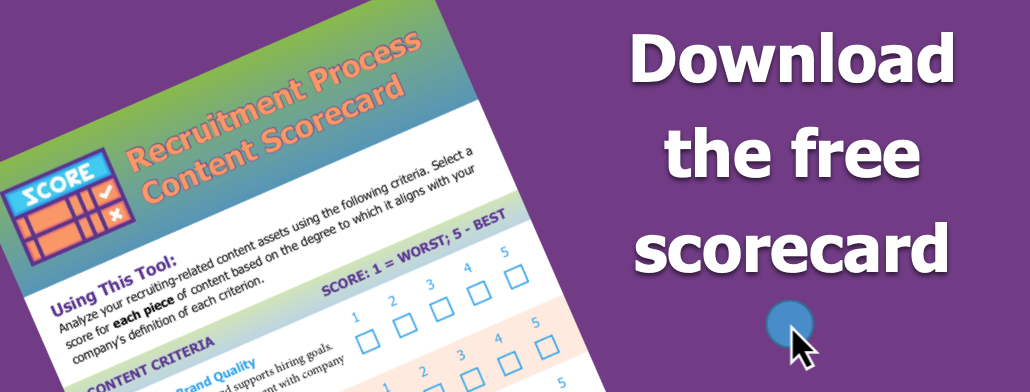How to Develop a Strategy for Each Stage of the Recruitment Process
What if your company managed its recruitment process exceptionally well? You would find and hire the right candidate on time and on budget. That new hire would evolve into a long-term, highly productive employee. If your company mastered recruiting, you would repeat this process over and over again.
And—get this—your entire organization would be twice as successful.
Data gathered by the SHRM Foundation found that companies that mastered their recruiting process enjoyed twice the profit margin when compared to companies with poor recruitment performance. It isn’t a surprising finding considering U.S. companies spend $140 billion to find and hire candidates.
Despite the investment and potential of the recruitment and selection process, too many companies treat it like a pesky maintenance problem. HR is expected to fill an open position quickly, as if the empty chair were nothing more than a missing cog in the wheel.
In fact, the employee selection process in HR management is an investment in the organization. The company should understand its employees are a key driver of the organization’s success. Then it can ask “what is the recruitment process” and “what are the steps of the selection process.”
Recruitment Process Steps
Articles on the recruitment and selection process often recommend breaking down the method of talent acquisition into actionable steps. These steps can be further managed using applicant tracking software.
The SHRM Foundation identifies five key steps in the recruitment process.
The recruitment process stages start with establishing recruitment objectives. With the objectives in hand, you can develop a recruitment strategy. This strategy will help you breeze through the next step, which is carrying out recruitment activities. With that third step completed, you’ll have the data you need for the last two steps: measuring recruitment results and evaluating recruitment efforts.
Talent Acquisition Process Example: Create Objectives
Your recruitment objectives should be the intersection of the company’s goals and an assessment of the labor market. The qualities you’re seeking in a candidate should align with the company’s mission.
For example, if a construction company is angling to be more high-tech than its competitors, then it may look for workers comfortable using emerging robot and AI technology. An examination of the labor market will tell this construction company how plentiful these workers are. Using applicant tracking software, the construction company can customize an application to screen for these skills.
Knowing what you’re looking for in an ideal candidate and understanding how likely you are to find that person in the labor market will help you as you determine your other recruitment objectives.
Qualifications will likely come to mind when considering what is the first step in the recruitment and selection process. Next, you may set a timeline for having the position filled. While the position’s qualifications and timeline are essential objectives, HR managers can take their recruitment practices to the next level if they consider a few more goals.
As a recruitment process example, knowing how much the organization will spend on each new hire will help you coordinate with the company’s officers to plan for the highest return on investment. You’ll gain powerful allies when you help your company’s key decision makers understand how the resources expended to find and train new hires translates into actual dollars.
When talent retention is translated into dollar figures, you’ll recruit willing members to your recruitment team, starting with the position’s supervisor. You can work with this manager to update your position’s profile and assess how the role coordinates with the team.
The best recruitment process will help everyone who interacts with the new hire understand that finding the right candidate, supporting his success and encouraging him to stay with the company long-term is crucial to the company’s success.
Recruitment Process Step: Plan A Strategy
Once you know your recruitment goals, the next step is to devise your employer recruiting strategy to reach them. In this phase, you’ll create a recruitment process flow with actionable steps that will make your recruitment process a success.
You may find, while updating the job’s profile, that an entry level position requires knowledge of newer software. Your strategy can include applicant tracking software to create assessments to evaluate applicants’ competence.
If your open position requires a high level of performance, you may consider targeting applicants who are currently and successfully employed. If you have a tight deadline, your strategy may include generating many applicants in a short period of time. Software can help you track all of your applicants and help you ensure you’re complying with federal reporting laws to which your organization may be subject like Affirmative Action and EEO.
Perform Recruiting Activities
The objectives you’ve already identified will help you access the types of recruitment process activities that will net the best applicants.
For high level positions, you may decide to use a recruiting professional. Such an expert will be especially helpful if your ideal employee is already employed. Industry events and old-fashioned networking can also help you find quality candidates who may not be actively seeking a new job. On the other hand, you may decide to use a local staffing agency for entry level positions.
No matter what position you have open, job boards will help you cast a wide net. You can use applicant tracking software to post to multiple boards in one step. You’ll also be able to sort the applications by assigning a status to each one.
Measure Recruiting Process Results And Evaluate Success
Evaluate your recruiting process metrics as your search continues. Are you getting the number and quality of applicants you expected? If not, you may need to adjust your strategy.
You can run applicant and job reports using applicant tracking software to access your progress. Ultimately, the success of your recruitment process will hinge on one result: a high-performing new hire that evolves into a long-term employee.
Formally evaluate recruitment process success annually. Then you can uncover which recruitment methods yield employees who are likely to stay with the company. Evaluating your recruitment process can have another benefit. Your results can convince decision makers that finding and retaining great employees can improve the company’s revenue.
You can make targeted improvements to the key problem areas you identify in your evaluation. For example, if you find that new hires are more likely to stay with the company for more than two years if they are referred by a current employee, you can create an employee referral program with incentives.
You may also find previous assumptions were unfounded. For example, you may have been favoring applicants with experience only to find the new graduates perform just as well and stay with the company longer.
Developing a strategy for each stage of the recruitment process does more than fill your company’s empty chairs. It significantly impacts your company’s success. A winning recruitment process strategy will find and hire the best candidates. It will also encourage them to stick with the company for years to come. Carefully planning and carrying out your recruitment strategy will help you make the most of a resource with boundless potential: your employees.
Want More Resources to Evaluate Your Recruitment Process? Download Our Scorecard!
Photo by mentatdgt from Pexels










 15% OFF FULL-SERVICE HIRING • APPLICANT TRACKING SOFTWARE • ONBOARDING SOFTWARE
15% OFF FULL-SERVICE HIRING • APPLICANT TRACKING SOFTWARE • ONBOARDING SOFTWARE